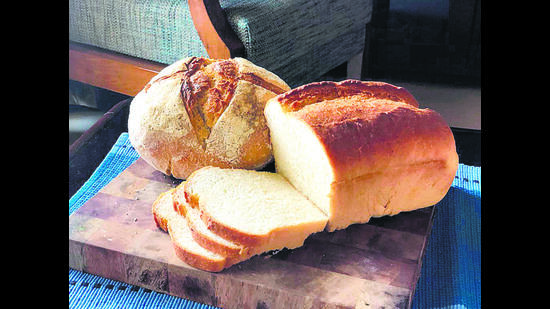
India may have joined the bread revolution late, but once it did, there was no going back. Today, there are many varieties of breads being made, with the newest addition being artisanal breads. Bakers are creatively playing with the dough to make appetising preparations such as cheese and rosemary brioches, apple cider oatmeal and classic beer breads. “Changing consumer habits and lifestyle are shaping the bakery industry in India. While artisanal bread has always enjoyed a dedicated audience, its growing and diverse range of global flavours and ingredients are attracting new followers,” says Utkarsh Bhalla, chef at Sly Granny. Sweet breads made with brown sugar, honey and jaggery, and the ones with healthy and refreshing herbs and spices are also becoming popular.
Due to the extended fermentation time used, artisanal bread has more flavour and aroma than the supermarket variety. The former has a wheaty flavour, which can range from mild and somewhat sweet to tangy and sour. They can have a variety of textures as well — crunchy, chewy or soft. “Long fermentation allows the dough to develop more organic acids and maturing properties, which creates flavour and aids the gluten structure for a lighter and more enjoyable bread,” says Bhalla.

The word artisan has its roots in the French language and designates any person who exercises a craft or profession using traditional skills, as opposed to more industrial and mechanised methods of production. “At least in France, all breads used to be produced in family owned and operated bakeries, so all their products were, by definition, artisanal. This changed with industrialisation and the changes in the working, living and eating habits in the 20th century,” says Kazem Samandari, chef and executive chairman at L’Opéra.
Speaking of India, he explains that the bread culture here was earlier confined to homemade breads like chapati, puri, roti, bajra rotla, thepla, appam and more. “The British later introduced toast bread, which were first produced in smaller, family-run companies and then by industrial units. But now, the trend of artisanal bread has accelerated significantly, receiving a push during the pandemic and even later. And what started from the simple sourdough has become experimental with multiple flavours,” adds Samandari.

The popularity of artisanal breads can also be credited to lifestyle shifts and mindful eating habits. Baguette, sourdough, focacia, rye bread, ciabatta, spelt bread, panettone, multigrain are some of the popular varieties. “Artisanal bread-baking at home took off during the pandemic. Everyone wanted to learn to bake and social media propagated the trend. We taught over 200 people across the globe in the last two years and eight of our students now run full-time artisanal bakeries in different parts of the country,” says Dipesh Dutt Sharma, a baker at The Enthubakers.
Common mistakes to avoid
Adding salt directly on top of yeast.
Not covering up your dough at all stages of bread-making.
Inadequately proofing your dough.
Adding too much liquid.
Kneading your bread too little
Failure to create steam in the oven.
Your bread will not rise if your yeast doesn’t live. The ideal temperature of water for preparing the dough is between 1°C and 6°C. If the water is too hot, you can kill the yeast. If it’s too cold, the yeast won’t activate.
Slicing warm bread affects its texture and flavour. The bread will be gummier and less airy, and will stale and dry out much faster.
Things to keep in mind while baking at home
Flour, water, salt and yeast are the key ingredients of most artisanal breads. The lack of chemical additives in its ingredients list is a sign that it is truly artisanal.
Herbs and spices like mustard powder, paprika, cinnamon and grated courgette are great additions.
Adding butter (unsalted) or oil (olive or vegetable) in small quantities to bread results in a higher rise, a crisper crust and a longer shelf life.
Knead the dough until it is smooth and elastic. Add grated cheese to it.
After the bread has proofed (rested and risen) sufficiently, it should be baked soon. If you wait too long, it can overproof, which will cause a sour taste and large holes in the final product.
Egg wash turns the bread golden and gives a softer crust.
Milk washes in the last few minutes are good for a sandwich-style loaf and give a glossy brown, soft crust.

Recipe
No knead artisan bread
Ingredients:
300gms flour
190 gms water
6 gms salt
2 gms instant/active yeast
Process:
Mix all the ingredients in a large mixing bowl to form a shaggy dough. Cover with shower cap or plastic and leave at room temp for 8-12 hours (22-25 deg - typically a room where ac is on - so best is to leave in an ac room overnight where you are sleeping).
The dough would have expanded. Tip and scrape it out on a floured surface and gently fold it over itself in a rough round ball or a log. Place that on baking tray lined with a floured baking sheet. cover with a damp towel or a large bowl and let is proof for about an hour at room temp.
Preheat oven to 220 deg. Place the the tray with the dough in the heated oven. Spray the inside of the oven with water and throw some ice cubes in the bottom of the oven to create steam. The bread should bake in 40-50 mins to bake. Cool completely before slicing.
Recipe by Dipesh Dutt Sharma, baker


